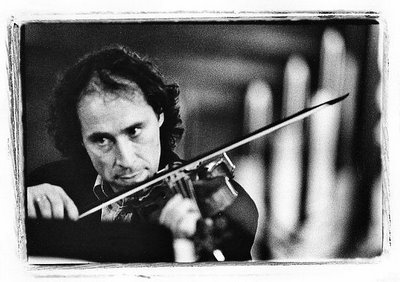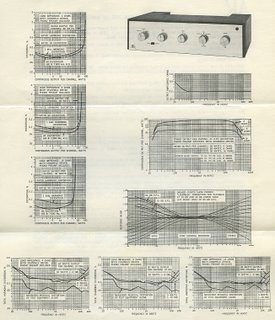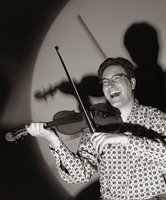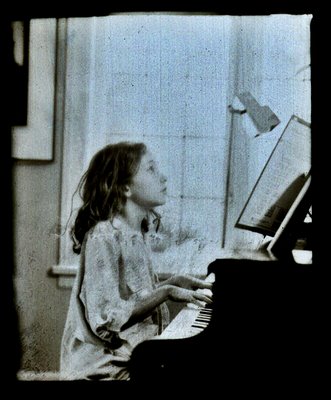Marc Destrubé - The Intimate Violinist & The Sony Clock Radio
Sunday, December 16, 2007

Some years ago I dined in the wine cellar of Villa Del Lupo restaurant with violinist Marc Destrubé. Over ostrich and a Sancerre wine I heard the most fascinating information related to the violin's chin rest. Up until the beginning of the 19th century violinists played in smaller, much more intimate venues. They were the salons of kings, dukes and rich patrons. But with the advent of the 19th century and a rising middle class (and the chopping off of many of those dukes's heads) music halls got bigger as musicians tried to lure the common person. The rich sweet but not too loud sound of the baroque violin (and viola, etc) had to be made louder. The violin's internal structure had to be beefed up to allow for increased string tension. The violin could no longer be held loosely by the neck. It had to be held firmly. A contemporary of Beethoven, Ludwig Spohr came up with the idea of the chin rest.
It was here that Destrubé came up with the startling piece of information that has haunted me since. "Until the advent of the chin rest the intimacy and interpretation of a composer was limited to the playing of the music as written with small variations. But with the chin rest the violinist could hear the music in his head and became moved by it. Now the violinist could interpret the music as he heard it." So the paradox here is that the perhaps less rich and gently sound of the baroque violin could not elicit a personal expression by the musician as much as the modern and louder version. Perhaps I cannot completely accept this, but then I am not a violinist. Destrubé is not only a master of the baroque violin and the composers of the 17th and 18th century but he can also play and masters the composers of the 19th, 20th and 21st century.
But all that reminds me of the connection between Rebecca's Christmas gift this year and my venture into high fidelity around 1970. Until then my idea of high fidelity were Gerrard turtables that permanently scarred the best records of my collection and piddly amplifiers that clipped and distorted all frequencies. It was around 1969 that I saw and ad for Acoustic Research speakers.

It featured a string trio in a New England forrest with a couple of AR-3A speakers on either side. The explanation under the photo said that at moments when the live playing was switched to a recorded version by the same trio, bystanders could not tell the difference.
Acoustic Reseach thus advertised accurate sound, as did the classical recordings of Angel Records. I has hoocked to this idea. I soon got my wish. A Cuban friend in need of money sold me his Acoustic Research amplifier (a transistor amplifier with minimal knobs and at the time a whopping 100 wats RMS per channel). The amplifier came with a AR turntable which was simple and beautiful. All I needed were speakers. A neighbour worked for the Mexican petroleum company (PEMEX) so my US purchased AR-3A speakers came listed as oil pumps. At the time Mexico had an importation ban on all sound equipment.
So it was that I leaned to appreciate the accuracy of this sort of sound. Not all that accurate as I particularly loved and love such records (and now CDs) by Gerry Mulligan that had a marked separation between stereo channels. Mulligan on the left, Chet Baker on the right. I never adopted quadraphonic and much less the sound of contemporary home theatre sound. The idea of enhanced bass is anathema.
But I do remember seeing 2001 - A Space Odyssey in 1968 in a very good Mexican theatre and being enthralled by the then primitive idea of surround sound. And as soon as I had my AR amplifier I purchased an Angel recording of Richard Strauss's tone poem Also Sprach Zarathustra, op. 30 used so memorably in that film. Any audiophile who had decent equipment at the time would test the system against the reproduction (with the hopes of minimal distortion) of the bass pedal sounds of the organ in the beginning of this music.

Rebecca and I often go to listen to the Pacific Baroque Orchestra with Marc Destrubé (alas not the musical director anymore). We sit on the front row and sometimes opt to sit on the side of the cello and violon so that the violin is balance out. Rebecca understands. The PBO particularly when the younger Paul Luchkow, right, has a hand in it, every once in while surprises us and delights us with their version of the Gerry Mulligan jazz records. Violins on the left will be often challenged by violas on the right!
All the above will be a long winded explanation as to why Rebecca is getting a Sony clock radio/CD player (it glows blue in the dark) for Christmas. I have found her often listening to her music at her father's computer with earphones.

I never fell for the idea of having music in my head. I never bought earphones. I will never know what it is to listen to music as heard by one playing a violin with a chin rest. The closest will always be some variation of the terrible experience of watching Reese Witherspoon in Legally Blonde on board a Continental Airlines Boeing.
I have told Rebecca that without air there is no sound. On the moon we would not hear anything. Sound exists because of air. Air affects and modifies sound. I want her to grow up with an idea of sound one hears with the echoes and reverbation of a living room, or in her case on her night table.
My friend Tim Bray is a master of all that is new. He listens to music on his i-Pod but he is aware of the defficiency and the sacrifice one makes for the ability to be able to listen from a menu of 25,000 songs. So he uses a tube amplifier to "improve" or bring back some of the sound quality lost in compression.
This loss of quality in sound was beautifully explained by Anthony Tommasini here.






